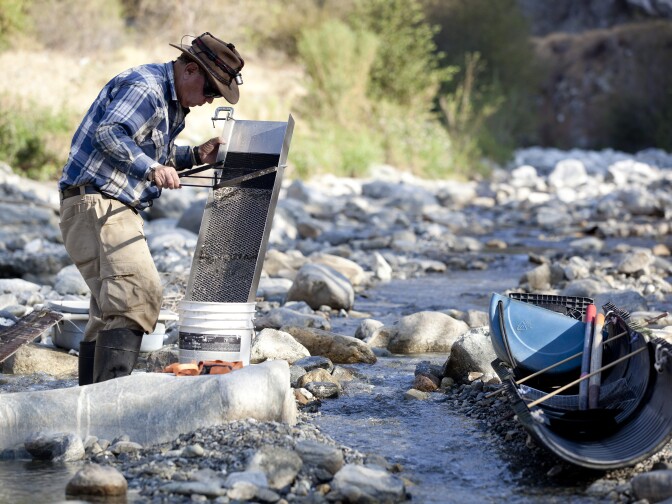Truth matters. Community matters. Your support makes both possible. LAist is one of the few places where news remains independent and free from political and corporate influence. Stand up for truth and for LAist. Make your year-end tax-deductible gift now.
This archival content was originally written for and published on KPCC.org. Keep in mind that links and images may no longer work — and references may be outdated.
Forest officials want volunteers to help crack down on gold panning in San Gabriel Mountains
If you've ever visited the San Gabriel River in the mountains north of Azusa, you've probably seen folks standing ankle deep in the water panning for gold.
You're not supposed to do it, but there hasn't been much enforcement.
Now the U.S. Forest Service wants to crack down on gold prospectors. Since 2014, this area has been part a national monument and that means increased environmental protections.
The new plan for the San Gabriel Mountains National Monument says “mineral collection for non-commercial personal uses is not suitable.”
That prohibition covers activity within the monument's 340,000 or so acres.

Mining is allowed if you hold a claim. But forest officials say those existing mining claims exist in less than 2,000 acres of the monument. For the most part, according to the management plan, those mining operations don't disturb the ground.
So what about recreational miners?
It was already illegal before the national monument designation. But enthusiasts worried from the start that authorities would start enforcing the rule. The new plan notes that the people did speak about the "value in recreational gold panning" during public comments.
The next sentence: "An additional plan standard and a revised suitability of lands table updated the Monument Plan to emphasize that prospecting, including recreational gold panning and mineral collecting are prohibited activities."
The new plan calls for coordination between local, state and federal agencies to enforce the rules. One way they believe they can do that is to "develop partnerships with local volunteer groups to document illegal mining activities."
They also want to educate visitors about the ecological damage of illegal mining. The forest service says it wants to protect habitat for threatened species like the yellow-legged frog and fish called the Santa Ana sucker.
The area has a rich Gold Rush history, and there are still remnants of those days. From the management plan:
Eldoradoville was a town established in the mid-to-late 1850s to support the mining operations in the East Fork of the San Gabriel River. The town was ultimately destroyed during the flood of 1938, but what remains is still located at the confluence of Cattle Canyon and the East Fork of the San Gabriel River.
The site consists of a series of concrete pads, retaining walls, a cobble rockwork flagpole base, and nonnative vegetation on the primary terrace above the East Fork of the San Gabriel River. Earlier placer workings are located upstream. Placer mining is the mining of the streambed for gravel deposits and can involve washing, dredging, or hydraulic mining.
The site is the approximate geographic location of the historic “Prospect Bar” and “Eldoradoville” mining towns of the mid-1800s, historic “Camp Bonita” of the Great Hiking Era, and the historic “'Hooverville” of the 1930s. The remains are most consistent with the 1909 to 1938 Camp Bonita occupation.
In May 1859, a gold mining boom town known as Prospect Bar, consisting of a boarding house, two or three stores, post office, blacksmith, saloon, butcher shop, etc., arose during a flurry of mining activity on the East Fork of the San Gabriel River. That settlement was described as being located 4 miles up the East Fork, near the confluence of that stream and Cattle Canyon. The site was flooded out in a storm in November 1859. By March 1860, the miners had returned and formed a mining district, naming the town Eldoradoville.
The town was a lawless Wild West settlement, governed by the knife and gun.
If you want to share your thoughts on the final version of this plan, the public has the next 45 days to comment.
Here are the details:









